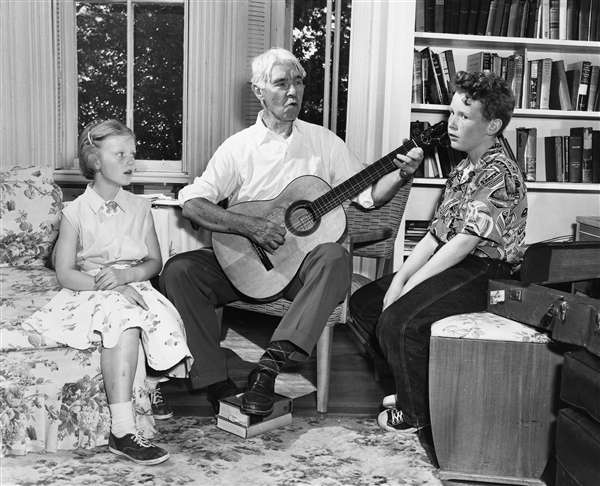|
_______________________________________________________
#5 15 March 2024
Sandburg singing with his grandchildren in the living room of his farm in North Carolina.
The Old Troubadour
By John W. Quinley Dear Readers,
Released in 1926, “The Boll Weevil” was Sandburg’s
first recording of a folk song. In the notes to this song, he muses “perhaps,
that in our mortal life neither the individual human creature, nor the big human
family shall ever find a lasting home on the earth.” When Sandburg added folk songs to his public lectures,
he drew larger and larger audiences, saying, “If you don’t care for them and
want to leave the hall it will be all right with me. I’ll only be doing what I’d
be doing if I were at home, anyway.” They stayed, and for the rest of his long
and prolific life, Sandburg sang on stages across the country. The moniker “the
old troubadour” given to Sandburg by his friend, architect Frank Lloyd Wright,
stuck. There was a haunting quality
to his voice, which he delivered with impeccable timing. Sandburg biographer
Harry Golden shared that “I’ve heard him sing in a huge auditorium in a whisper,
and yet the entire audience sat silent, spellbound.”
Chicago Daily News
colleague Lloyd Lewis remarked that “Sandburg may not be a great singer, but his
singing is great. He is the last of the troubadours; the last of the nomad
artists who hunted out the songs people made up, and then sang them back to the
people like a revelation.” Lewis continued:
Sandburg accompanied himself on a guitar with no
additional musicians singing or playing instruments. Even after classical guitar
icon Andrés Segovia gave him a few lessons and composed a little practice piece,
writing “for my dear Sandburg to teach his fingers as if they were little
children,” he strummed with two fingers and stayed within two keys, A and C. He
sarcastically said of his playing, “If I’d gotten a prison sentence, I’d
probably have become pretty good on the guitar.” Sandburg became increasingly in demand on stages and in
halls across America, often performing for three or more months at a time. By
the late 1920s, he estimated that he had performed at about two-thirds of the
colleges and universities in the country. In 1936, he gave thirty platform
performances in seventy days, traveling through a dozen states and Canada.
During the 1950s when he was in his seventies, Sandburg continued to perform
extensively. He gave concerts to an audience of 9,000 at the University of
California and performed in front of 3,000 admirers at the Genial Federation of
Women’s Club in Asheville, North Carolina. He was so much in demand that he
turned down hundreds of invitations each year, ensuring there was ample time for
his poetry, biography, journalism, and other pursuits, regardless of monetary
considerations. His reach was extended further by the release of twelve records
folk songs. Though he may not have looked the part, he was a rock star. Thanks for reading,
John Quinley is the author of Discovering Carl
Sandburg: The Eclectic Life of an American Icon and is a former docent at
the Carl Sandburg Home National Historic Site in Flat Rock, North Carolina.
| ||||||||||||||||||||||||

